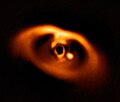References
- ↑ Roman, Nancy G. (1987). "Identification of a constellation from a position". Publications of the Astronomical Society of the Pacific . 99 (617): 695. Bibcode:1987PASP...99..695R. doi: 10.1086/132034 . Constellation record for this object at VizieR .
- 1 2 3 4 5 Brown, A. G. A.; et al. (Gaia collaboration) (2021). "Gaia Early Data Release 3: Summary of the contents and survey properties". Astronomy & Astrophysics . 649: A1. arXiv: 2012.01533 . Bibcode:2021A&A...649A...1G. doi: 10.1051/0004-6361/202039657 . S2CID 227254300. (Erratum: doi:10.1051/0004-6361/202039657e). Gaia EDR3 record for this source at VizieR .
- 1 2 Henden, A. A.; et al. (2016). "VizieR Online Data Catalog: AAVSO Photometric All Sky Survey (APASS) DR9 (Henden+, 2016)". VizieR On-line Data Catalog: II/336. Originally Published in: 2015AAS...22533616H. 2336. Bibcode:2016yCat.2336....0H. Vizier catalog entry
- 1 2 3 4 Nespral, D.; et al. (2017). "Mass determination of K2-19b and K2-19c from radial velocities and transit timing variations". Astronomy and Astrophysics. 601 A128. arXiv: 1604.01265 . Bibcode: 2017A&A...601A.128N . doi: 10.1051/0004-6361/201628639 . S2CID 55978628.
- 1 2 3 4 Sinukoff, Evan; et al. (2016). "Eleven Multiplanet Systems From K2 Campaigns 1 and 2 and the Masses of Two Hot Super-Earths". The Astrophysical Journal. 827 (1) 78. arXiv: 1511.09213 . Bibcode: 2016ApJ...827...78S . doi: 10.3847/0004-637X/827/1/78 .
- 1 2 3 Skrutskie, Michael F.; et al. (1 February 2006). "The Two Micron All Sky Survey (2MASS)". The Astronomical Journal. 131 (2): 1163–1183. Bibcode: 2006AJ....131.1163S . doi: 10.1086/498708 . Vizier catalog entry
- 1 2 Armstrong, David J.; et al. (2015). "One of the closest exoplanet pairs to the 3:2 mean motion resonance: K2-19b and c". Astronomy and Astrophysics. 582 A33. arXiv: 1503.00692 . Bibcode: 2015A&A...582A..33A . doi: 10.1051/0004-6361/201526008 . S2CID 8463154.
- 1 2 Barros, S. C. C.; et al. (2015). "Photodynamical mass determination of the multiplanetary system K2-19". Monthly Notices of the Royal Astronomical Society. 454 (4): 4267–4276. arXiv: 1510.01047 . Bibcode: 2015MNRAS.454.4267B . doi: 10.1093/mnras/stv2271 .
- ↑ Narita, Norio; et al. (2015). "Characterization of the K2-19 Multiple-transiting Planetary System via High-dispersion Spectroscopy, AO Imaging, and Transit Timing Variations". The Astrophysical Journal. 815 (1) 47. arXiv: 1510.01060 . Bibcode: 2015ApJ...815...47N . doi: 10.1088/0004-637X/815/1/47 .
- ↑ "K2-19". SIMBAD . Centre de données astronomiques de Strasbourg . Retrieved 2018-12-31.
- ↑ Foreman-Mackey, Daniel; et al. (2015). "A Systematic Search for Transiting Planets in the K2 Data". The Astrophysical Journal. 806 (2) 215. arXiv: 1502.04715 . Bibcode: 2015ApJ...806..215F . doi: 10.1088/0004-637X/806/2/215 .
- ↑ Montet, Benjamin T.; et al. (2015). "Stellar and Planetary Properties of K2 Campaign 1 Candidates and Validation of 17 Planets, Including a Planet Receiving Earth-like Insolation". The Astrophysical Journal. 809 (1) 25. arXiv: 1503.07866 . Bibcode: 2015ApJ...809...25M . doi: 10.1088/0004-637X/809/1/25 .
- ↑ Vanderburg, Andrew; et al. (2016). "Planetary Candidates from the First Year of the K2 Mission". The Astrophysical Journal Supplement Series. 222 (1) 14. arXiv: 1511.07820 . Bibcode: 2016ApJS..222...14V . doi: 10.3847/0067-0049/222/1/14 .
- 1 2 Petigura, Erik A.; et al. (January 2020). "K2-19b and c are in a 3:2 Commensurability but out of Resonance: A Challenge to Planet Assembly by Convergent Migration". The Astronomical Journal. 159 (1) 2. arXiv: 1910.12899 . Bibcode: 2020AJ....159....2P . doi: 10.3847/1538-3881/ab5220 .
- ↑ Petit, Antoine C; Petigura, Erik A; Davies, Melvyn B; Johansen, Anders (2020-08-11). "Resonance in the K2-19 system is at odds with its high reported eccentricities". Monthly Notices of the Royal Astronomical Society. 496 (3): 3101–3111. arXiv: 2003.04931 . Bibcode: 2020MNRAS.496.3101P . doi: 10.1093/mnras/staa1736 .
- ↑ Williams, David R. (2018-09-27). "Mercury Fact Sheet". NASA. Retrieved 2019-01-12.
- ↑ Kokori, A.; et al. (14 February 2023). "ExoClock Project. III. 450 New Exoplanet Ephemerides from Ground and Space Observations". The Astrophysical Journal Supplement Series. 265 (1) 4. arXiv: 2209.09673 . Bibcode: 2023ApJS..265....4K . doi: 10.3847/1538-4365/ac9da4 .
